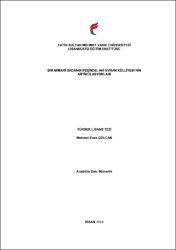Bir Mimarî Sadânın Peşinde : Ahi Evran Külliyesi’nin Artikülasyonları
Künye
GÜLCAN, Mehmet Enes, Bir Mimarî Sadânın Peşinde : Ahi Evran Külliyesi’nin Artikülasyonları, Fatih Sultan Mehmet Vakıf Üniversitesi Lisansüstü Eğitim Enstitüsü Mimarlık Anabilim Dalı, Yayımlanmamış Yüksek Lisans Tezi, 2019.Özet
Bu çalışma, mimarlık pratiği içerisinde kendilerine mahsus anlamlar barındıran “sadâ” ve “artikülasyon” kavramlarının, mimari bir dilin üretiminde ne tür tanımlamalar ile karşılık bulduklarıyla alakalıdır. Bu doğrultuda, Türkiye’deki geleneksel yapı teknolojisine ait güncel uygulamaların artikülasyonları üzerinden, mekansâl üretimi meydana getiren form ve yapı detayları incelenmektedir. Hususi olarak, taş ve ahşap gibi geleneksel yapı malzemelerinin betonarme ile birlikte çözümlendiği Kırşehir’deki Ahi Evran Külliyesi, mekânsal oluşumunu mümkün kılan form ve yapı detaylarının üretiminde kullanılan malzemelerin olanaklarını değerlendirme şeklinden ötürü bu çalışmanın odak noktası konumundadır. Bu çalışmada, bahsi geçen yapının artikülasyonları bağlamında ele alınan malzemelerin ve bunlardan üretilen yapı detaylarının, mimarlık pratiği içerisinde geleneksel yapı teknolojisine ve üretimlerine eklemlenerek mevcut olan ürünlerin farklı mecralarda yeniden gündeme getirilmesi tartışılmaktadır. Bu çalışmayla hedeflenen, dilin ifade kabiliyetini oluşturan artiküler hareketlerin, mimarlığın üretiminde mekânsal bütünlüğü meydana getiren yapı detaylarıyla benzerliğini saptamaktır. This study related to how the concepts of “sadâ” and “articulation”, which have their own meaning in architectural practice, are used in the production of an architectural language. In this respect, articulations out of the current practices of traditional building technologies in Turkey, forming the spatial form and structure of production details are examined. In particular, the Ahi Evran Complex in Kırşehir, where traditional building materials such as stone and wood are used together with reinforced concrete, is the focus of this study because of the way in which it assesses the possibilities of the material usage in the production of the form and structure details that make the spatial formation possible. In this study, it is argued that the materials discussed in the context of articulation of said structure and the structural details produced there from are added to the traditional construction technology and production in the architectural practice and that the existing one is brought up again in different media. The aim of this study is to show the similarity of the articular movements, which constitute the expression ability of the language, with the structural details that create the spatial integrity in the production of architecture.



















